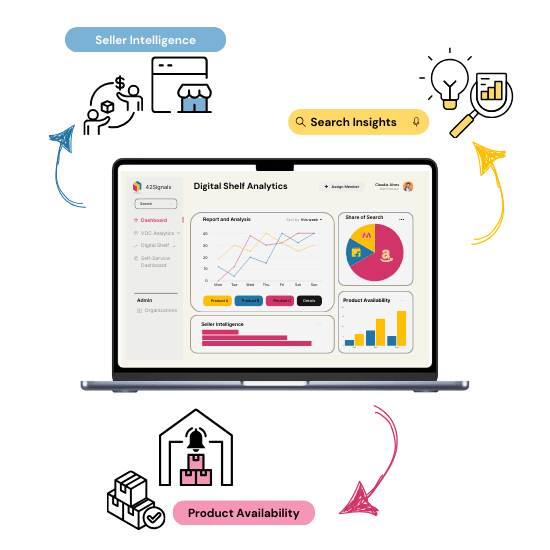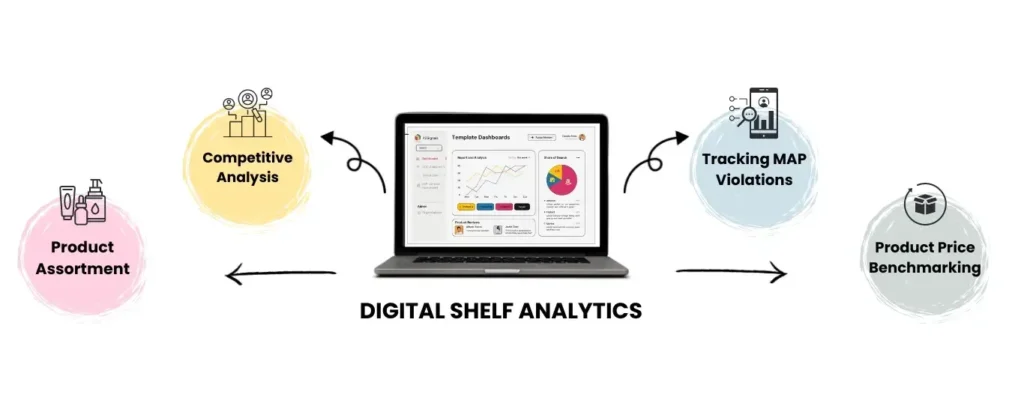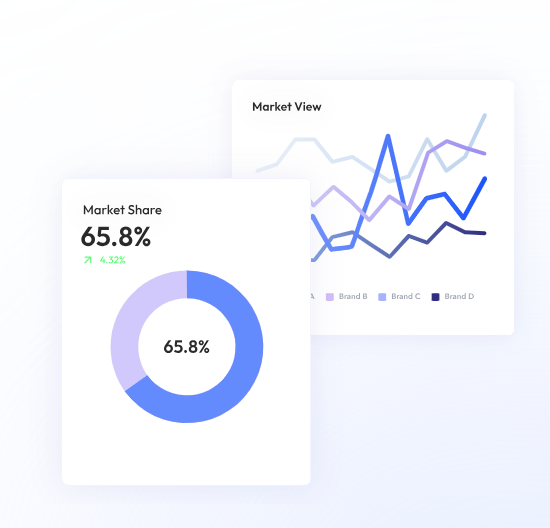Table of Contents
ToggleAs e-commerce continues to rise in prominence and more brands strive to make their mark online, the importance of optimizing one’s digital shelf becomes even more significant. Digital shelf analytics tools provide the data-driven insights needed to understand how products perform online, optimize content, drive sales, and ultimately enhance the consumer shopping experience.
Let’s look at the top digital shelf analytics platforms of 2025, and understand how they compare.
What is Digital Shelf Analytics?
Before we dive into the comparisons, let’s quickly understand what digital shelf analytics entails. Essentially, these tools help brands gain insights into their products’ performance on e-commerce platforms.
This includes tracking product visibility, availability, pricing, content accuracy, and customer reviews. The ultimate goal is to ensure the right products are displayed with the right content, at the right price, and in the right places.

Top Digital Shelf Analytics Platforms in 2025
1. 42Signals – #1 Digital Shelf Analytics Provider
A leader in e-commerce analytics, 42Signals provides an in-depth digital shelf analytics solution. We transform fragmented data into a unified command center for e-commerce excellence, enabling brands to protect margins, amplify visibility, and outmaneuver competitors.

Features:
- Real-time Monitoring: 42Signals provides a dashboard that captures product performance across numerous online channels, helping brands stay responsive to market changes.
- Competitive Benchmarking: This feature lets brands see how their products measure against competitors, illuminating potential areas of improvement.
- Content Optimization: 42Signals ensures that product listings are accurate, up-to-date, and engaging, increasing the likelihood of conversions.
Strengths: Beyond its feature-rich offering, 42Signals stands out for its AI-powered insights and user-friendly interface. Its ability to offer real-time digital shelf analytics across a spectrum of e-commerce platforms gives brands a panoramic view of their digital product performance.
Why 42Signals Is the Digital Shelf Analytics Leader: Unmatched Differentiators
a) Predictive AI, Not Reactive Dashboards
→ Our AI doesn’t just report data—it anticipates moves.
- Alert: “Competitor X will likely discount Product Y next week based on historical promo cycles + inventory glut.”
- Prescribe: “Increase Amazon Sponsored Ads budget for SKU #123 before the back-to-school demand surge.”
b) Unified Cross-Platform Governance
→ Control your brand’s entire digital footprint in one place:
- MAP Compliance: Auto-detect violations, generate violation reports, and track resolution rates.
- Global Price Parity: Enforce consistent pricing across regions/channels to prevent channel conflict.
- Assortment Gaps: Identify “hot” competitor products missing from your catalog.
c) Frictionless Integration into E-Commerce Workflows
- Automated Reporting: Schedule daily/weekly performance digests for teams or retail partners.
- Collaboration Hub: Annotate insights, assign tasks, and track resolutions within the platform.
- API Ecosystem: Sync data with your PIM, ERP, or BI tools (Tableau, Power BI).
Strengths That Cement Our Leadership in Digital Shelf Analytics
| Strength | Competitor Gap | Client Impact |
|---|---|---|
| AI-Driven Insights Engine | Competitors offer static dashboards; we deliver prescriptive intelligence. | Turn data into tactical plays (e.g., “Counter Competitor A’s discount with bundle offers”). |
| True Omnichannel Coverage | Most tools focus on Amazon; we track marketplaces, DTC sites, social commerce, and retail chains. | Holistic strategy alignment (e.g., “Walmart’s pricing is undercutting our DTC site—adjust now”). |
| Zero-Learning-Curve UI | Complex tools require data scientists; our interface is built for marketers and sales teams. | Decisions in minutes, not days. No training needed. |
2. Profitero
A global leader in e-commerce analytics, Profitero integrated digital shelf analytics, shelf intelligent activation, and advisory services empower brands to optimize availability, discoverability, and conversion — across 1,000+ retailers in 70+ countries.
Features:
- Detect and defend against competitors bidding on your brand keywords
- Get daily out-of-stock alerts by retailer so you can quickly replenish inventory
- Track retailer product pages to make sure all product content fields are correct and visible to shoppers
- Detect minimum advertising price (MAP) violations so you can enforce control with more confidence
- Get higher ROI from your advertising by knowing which products are converting the best.
Strengths: Profitero’s main strength lies in its exhaustive scanning ability, giving brands an almost real-time understanding of their digital shelf. Its specialized tools provide specific insights that many brands find invaluable.
3. Edge by Ascential
Recognized for its retail-driven insights, Edge by Ascential provides a suite of solutions that help brands optimize their e-commerce operations. Their digital shelf analytics tool is renowned for depth and accuracy.
Features:
- Retailer-specific Insights: Edge by Ascential offers analytics that is tailored to specific retailers, allowing brands to strategize accordingly.
- Content Compliance Monitoring: This tool checks product listings for accuracy and ensures they comply with retailer guidelines.
- Promotion Analytics: Understand how promotional activities are faring with detailed insights into performance and ROI.
- Inventory Monitoring: Prevent stock-outs or overstock situations by tracking inventory levels across various platforms.

Source: www.ascentialedge.com
Strengths: Edge by Ascential shines when it comes to offering retailer-specific data. Their content compliance tool ensures brands maintain a consistent and compliant digital presence across platforms. The promotion and inventory analytics further allow brands to strike the right balance in their marketing and stock management efforts.
Why 42Signals Stands Out as a Digital Shelf Analytics Provider?
While many analytics platforms overwhelm users with complexity, 42Signals delivers actionable clarity through purpose-built tools designed explicitly for e-commerce teams. Here’s how our platform transforms data into growth:

1. Tailored Intelligence, Not Generic Dashboards
- Custom Digital Shelf Analytics Reports Built for Your KPIs:
Unlike rigid templates, 42Signals lets you define success. Track share of search against niche competitors, monitor product availability in priority regions, or benchmark prices for specific SKUs – all in one configurable report. - Goal-Aligned Data Points:
Map insights directly to objectives. If “protecting brand integrity” is key, focus reports on MAP violations and pricing parity. If “new product launch” is critical, prioritize share of search trends and review velocity.
2. Visual Clarity for Faster Decisions
- Dynamic Visualization Studio:
Transform raw data into intuitive charts (bar, line, pie, heatmaps) with drag-and-drop ease. Spot pricing anomalies across 10 retailers at a glance or visualize inventory risk hotspots geographically. - Real-Time Alerts with Context:
Receive notifications not just that a MAP violation occurred, but where, by whom, and how it impacts your brand integrity. Alerts include suggested actions like automated cease-and-desist templates.
3. Unified Operations Control Center
- End-to-End Digital Shelf Command:
Consolidate fragmented metrics into one workflow:- MAP Violation Tracking: Automated detection & resolution workflows.
- Price Benchmarking: Real-time cross-channel price positioning.
- Assortment Optimization: Identify gaps vs. competitors’ top-performing SKUs.
- Collaboration Engine:
Share annotated reports with sales/marketing teams. Embed live dashboards in Slack or Teams to align on pricing strategies or inventory emergencies.
4. Vertical-Specific Value Unleashed
→ For B2C Brands:
- Decode category trends to optimize product mix.
- Track competitors’ promotions to time your discounts strategically.
→ For D2C Brands:
- Monitor real-time discount depth across channels to protect margins.
- Identify emerging competitors in niche social commerce platforms.
→ For Sales/Marketing Teams:
- Prove campaign ROI by correlating share of search spikes with sales lifts.
- Discover untapped keywords through competitor search dominance analysis.
The 42Signals Advantage: Turning Data into Dollars with Digital Shelf Analytics
| Feature | Operational Impact | Revenue Link |
|---|---|---|
| MAP Violation Tracking | Automated enforcement preserves brand premium & partner trust. | +12-25% margin protection on key SKUs. |
| Price Benchmarking | Instant cross-market price parity checks prevent channel conflict. | +8% sales volume from consistent pricing trust. |
| Assortment Optimization | Identify high-demand gaps vs. competitors; phase out underperformers. | +15% category sales from data-driven stocking. |
| Share of Search | Track visibility vs. rivals; adjust SEO/ads to capture high-intent traffic. | +20% conversion rate on prioritized keywords. |
Beyond Features: The Workflow Revolution
42Signals eliminates the “data detective” burden:
- Detect: Real-time alerts flag critical issues (stockouts, MAP breaches).
- Analyze: Custom reports show why it happened (e.g., competitor undercut pricing by 15%).
- Act: Built-in workflows guide next steps (adjust price, replenish inventory, enforce MAP).
- Optimize: Historical trends inform strategy (e.g., “Back-to-school discounts drove +30% share of search”).
Conclusion
As e-commerce continues to evolve, having the right digital shelf analytics tool can make all the difference. It’s not just about understanding how your products are performing, but also about adapting to changes quickly.
In the competitive landscape of 2025, 42Signals has made its mark by providing brands with the insights they need to thrive. Get in touch with us at sales@42signals.com for a custom demo.
Frequently Asked Questions
1. What is the digital shelf analytics process?
The digital analytics process involves collecting, analyzing, and interpreting data from digital channels to evaluate the performance of marketing campaigns, user behavior, website interactions, and other online activities. It typically begins with defining business goals, identifying key metrics, and setting up tracking mechanisms (like web analytics tools).
The data collected is then analyzed to generate insights that can help optimize strategies, improve user experiences, and drive business growth. Continuous monitoring and refining are essential components of this process to ensure alignment with evolving business objectives.
2. What is digital product analytics?
Digital product analytics refers to the practice of tracking and analyzing user interactions with a digital product—such as a website, app, or software platform—to understand how users engage with it.
This type of analytics focuses on metrics like feature usage, user retention, drop-off rates, and conversion funnels. The insights gained help product teams make informed decisions about improving product design, enhancing user experience, and increasing user satisfaction. It’s a data-driven approach aimed at maximizing product value and effectiveness.
3. Which of the following KPIs can be measured from a digital shelf?
From a digital shelf, the following Key Performance Indicators (KPIs) can be measured:
- Visibility: How well a product ranks in search results and category pages on an online platform.
- Click-Through Rate (CTR): The percentage of users who click on a product after seeing it on the digital shelf.
- Conversion Rate: The rate at which users make a purchase after visiting a product’s page.
- Share of Shelf: The proportion of your product listings compared to competitors on a specific digital shelf.
- Customer Reviews & Ratings: The volume and quality of customer feedback, reflecting user satisfaction and product credibility.
- Price Competitiveness: Comparison of a product’s price with similar products on the same platform.
- Stock Availability: How consistently the product is in stock, ensuring that potential customers can make a purchase.
These metrics come under digital shelf analytics.







